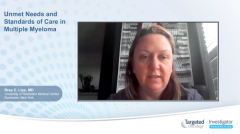
Closing Perspectives on MM Treatment and Care
Brea C. Lipe, MD closes this series highlighting the vast landscape of effective treatments and those on the horizon.
Episodes in this series
Summary
Brea C. Lipe, MD concludes this series reflecting on the data from the PERSEUS trial. The emergence of highly effective upfront regimens like DARA-VRd is not just expanding options but providing time - time for new treatments to become available, and time to optimize treatment sequencing. These potent combinations are extending survival so dramatically that it allows us to figure out ideal ways to leverage the many tools now available. Patients living longer is wonderful, but also an opportunity to carefully tailor regimens to each patient to enable them to live their best quality life. The variability seen in the data further demonstrates we can individualize modern regimens to meet patients where they are. With strong, tolerable regimens profoundly extending life, we can focus on mitigating side effects and keeping patients on treatment. The bottom line is today's excellent upfront options are a bridge to continued progress, buying time to optimize care until the next wave of advances. This is an exciting point in time for the myeloma field and for patients.
Summary was AI-generated and edited for clarity.















































